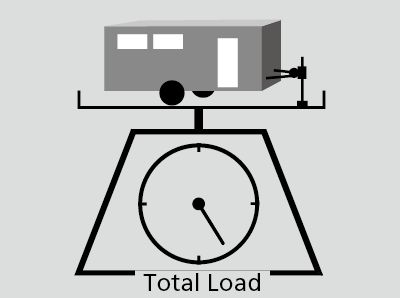Towing Preparation
Towing Load Limits
Your vehicle can tow a trailer if you carefully observe the load limits, use the proper equipment, and follow the towing guidelines. Check the load limits before driving.
|
Number of occupants
|
AWD models
|
2WD models
|
|
|---|---|---|---|
|
2
|
5,000 lbs (2,268 kg)
|
3,500 lbs (1,588 kg)
|
|
|
3
|
4,750 lbs (2,155 kg)
|
3,250 lbs (1,474 kg)
|
|
|
4
|
4,500 lbs (2,041 kg)
|
3,000 lbs (1,361 kg)
|
|
|
5
|
4,250 lbs (1,928 kg)
|
2,750 lbs (1,247 kg)
|
|
|
6
|
4,000 lbs (1,814 kg)
|
2,400 lbs (1,089 kg)
|
|
|
7
|
2,500 lbs (1,134 kg)
|
1,150 lbs (522 kg)
|
|
|
8*
|
Towing not recommended
|
||
Each weight limit is calculated based on the following conditions:
- Occupants fill seats from the front of the vehicle to the back.
- Each occupant weighs 150 lbs (68 kg).
- Each occupant has 17.6 lb (8 kg) cargo in the cargo area.
Any additional weight, cargo or accessories reduce the maximum trailer weight and maximum tongue load.
-
Tongue load
The weight of the tongue with a fully loaded trailer on the hitch should be approximately:
Boat trailers: 5 – 15% of the total trailer weight
Other trailers: 10 – 15% of total trailer weight -
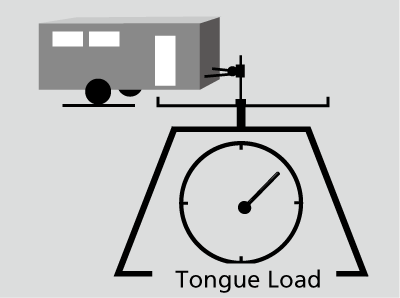
|
Number of occupants
|
AWD models
|
2WD models
|
|---|---|---|
|
2
|
500 lbs (227 kg)
|
350 lbs (159 kg)
|
|
3
|
475 lbs (215 kg)
|
325 lbs (147 kg)
|
|
4
|
450 lbs (204 kg)
|
300 lbs (136 kg)
|
|
5
|
375 lbs (170 kg)
|
275 lbs (125 kg)
|
|
6
|
250 lbs (113 kg)
|
240 lbs (109 kg)
|
|
7
|
125 lbs (57 kg)
|
115 lbs (52 kg)
|
|
8*
|
Towing not recommended
|
|
- WARNING
-
Exceeding any load limit or improperly loading your vehicle and trailer can cause a crash in which you can be seriously hurt or killed.
Check the loading of your vehicle and trailer carefully before starting to drive.
- Detail
-
Check if all loads are within limits at a public scale.
If a public scale is not available, add the estimated weight of your cargo load to the weight of your trailer (as quoted by the manufacturer), and then measure the tongue load with an appropriate scale or tongue gauge or estimate it based on cargo distribution.Refer to the trailer owner’s manual for additional information.Break-in Period
Avoid towing a trailer during your vehicle’s first 600 miles (1,000 km).
* Not available on all models
How to weigh the trailer loads using the public scale
Check each weight in the order indicated as shown.
Refer to the table on the right for each weight’s limit except for the tongue load.
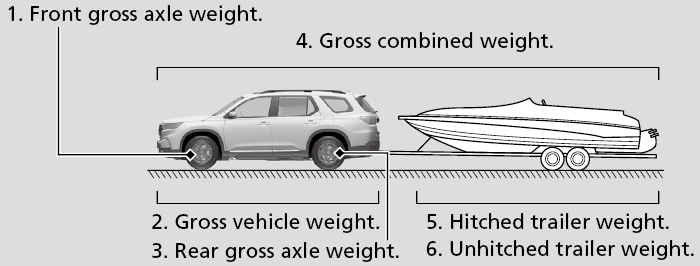
- If you cannot weigh the rear axle, subtract 1 from 2.
- The maximum gross combined weight (4) decreases by 2% for every 1,000 feet (305 meters) of elevation.
- To calculate the tongue load, subtract 5 from 6.
- Refer to the trailer owner’s manual for additional information.
- Detail
-
Fully load the vehicle and trailer. An attendant who watches the scale is needed as all occupants should stay in the vehicle.
Weight limit for2WD modelsAWD modelsFront gross axle2,976 lbs
(1,350 kg)2,998 lbs
(1,360 kg)Gross vehicle5,963 lbs
(2,705 kg)6,195 lbs
(2,810 kg)Rear gross axle3,164 lbs
(1,435 kg)3,340 lbs
(1,515 kg)Gross combined8,444 lbs
(3,830 kg)10,141 lbs
(4,600 kg)Weight limit forModels with trailer hitchFront gross axle2,998 lbs
(1,360 kg)Gross vehicle6,195 lbs
(2,810 kg)Rear gross axle3,384 lbs
(1,535 kg)Gross combined10,141 lbs
(4,600 kg)If a public scale is not available, add the estimated weight of your cargo load to the weight of your trailer (as quoted by the manufacturer), and then measure the tongue load with an appropriate scale or tongue gauge or estimate it based on cargo distribution.
Towing Equipment and Accessories
Towing generally requires a variety of supplemental equipment.
To ensure the best quality, we recommend that you purchase Honda equipment whenever possible.
-
Your vehicle has a class 3 trailer hitch as standard equipment.
-
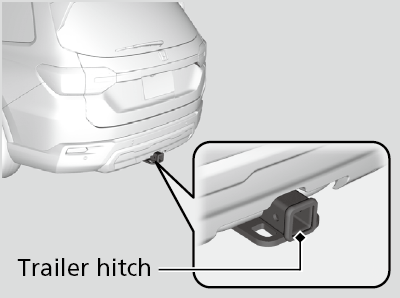
- Detail
-
Make sure that all equipment is properly installed and maintained, and that it meets federal, state, province/territory, and local regulations.Consult your trailer maker for proper installation and setup of the equipment.
Improper installation and setup can affect the handling, stability, and braking performance of your vehicle.Consult your trailer sales or rental agency if any other items are recommended or required for your towing situation.The lighting and wiring of trailers can vary by type and brand. If a connector is required, it should only be installed by a qualified technician.Trailer packages and products available at a dealer.- Ball mount kit.
- Hitch harness kit
- Trailer hitch kit
Trailer brakes
Recommended for any trailer with a total weight of 1,000 lbs (450 kg) or more:
There are two common types of trailer brakes: surge and electric. Surge brakes are common for boat trailers, since the brakes will get wet.
If you choose electric brakes, be sure they are electronically actuated. Do not attempt to attach trailer brakes to your vehicle’s hydraulic system, as it will lower braking effectiveness and create a potential hazard.
The 4-pin gray connector installed in your vehicle has all of the circuits required to install most electric trailer brake controllers.
-
Have a qualified mechanic install your trailer brake controller following the trailer brake controller manufacturer’s instructions. Failure to properly install the trailer brake controller may increase the distance it takes for you to stop your vehicle when towing a trailer.
-
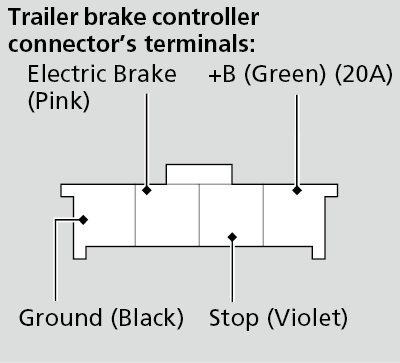
-
The trailer hitch harness is used to install the controller for the electric trailer brakes.
Insert the trailer brake fuse into the engine compartment fuse box. -
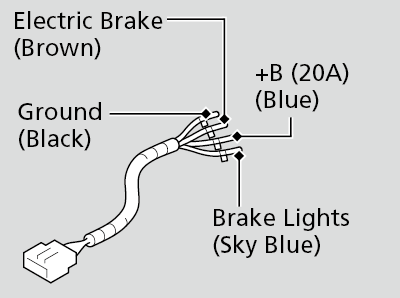
- Detail
-
The 4-pin gray connector is located under the dashboard near the driver’s side interior fuse box.
Trailer light
Trailer lights and equipment must comply with federal, state, province/territory, and local regulations. Check with your local trailer sales or rental agency for the requirements in the area where you plan to tow.
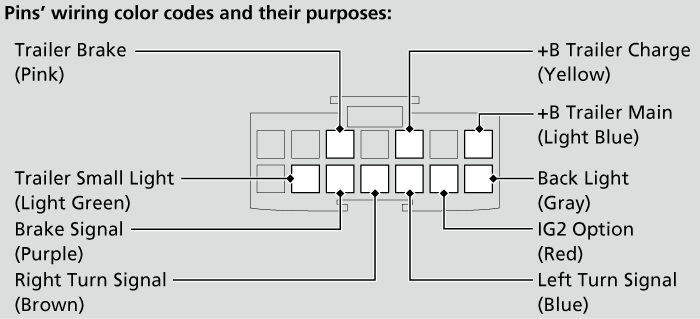
We recommend that you have a dealer install a Honda wiring harness and converter. They are designed for your vehicle.
The lighting and wiring of trailers can vary by type and brand. If a connector is required, it should only be installed by a qualified technician.
- Detail
-
The trailer lighting connector is located behind the left side panel in the cargo area.
Even if you are planning to use the non-Honda trailer lighting harness and converter, ask a dealer for the correct connector and pins.
Hitches
The hitch must be of an approved type and properly bolted to the underbody.
Weight distribution hitches
Your vehicle is designed to tow without the need for a load distributing hitch. If you wish to use one, please consult your trailer maker for proper installation and set-up.
Improper set-up could degrade the handling, stability, and braking performance of your vehicle.
Safety chains
Always use safety chains when you tow a trailer. Leave enough slack to allow the trailer to turn corners easily, but do not allow the chains to drag on the ground.
Sway control
This device can be used if your trailer tends to sway. Your trailer maker can tell you what kind of sway control you need and how to install it. Improper installation could degrade the handling and stability of your vehicle.
Trailer mirrors
Many states, provinces and territories require special exterior mirrors when towing a trailer. Install special mirrors whenever you cannot clearly see behind you, or if the trailer creates a blind spot.
- Recommended topic(s)

